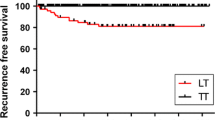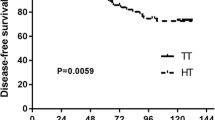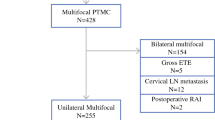Abstract
Introduction
Low-risk thyroid papillary microcarcinomas (PMCs) without evidence of metastasis grow slowly if at all. However, we recommended surgery for tumors touching the trachea (TR) or located in the course of the recurrent laryngeal nerve (RN). Here we compared the cases of low-risk PMC patients who underwent immediate surgery to cases of TR- and RN-involved PMCs.
Materials and methods
We enrolled 1143 low-risk PMC patients who underwent immediate surgery in the years 2006–2014. The PMCs of 437 patients touched the TR on imaging studies: 270, 104, and 63 were graded as low, intermediate, and high risk, respectively, for TR invasion based on the angles between the tumor and the TR surface. The tumor was in the course of the RN in 144 patients, with 35 graded low risk and 109 high risk for RN invasion based on the normal rim of the thyroid in the direction of the RN.
Results
Invasion of the TR cartilage was observed only in high-risk patients. Peritracheal connective tissue was resected in 21, 15, and 6 of the high-, intermediate- and low-risk patients, respectively. Significant invasion of the RN requiring complete resection was observed in only nine patients at high risk for RN invasion. The incidence of TR invasion in high- and intermediate patients and the incidence of RN invasion in the high-risk patients were significantly higher than those of the low-risk patients. Tumors <7 mm did not show TR or RN invasion.
Conclusion
Among PMCs that touched the TR or were located in the course of the RN, observation could be the first choice for tumors < 7 mm and those ≥ 7 mm judged as low risk for TR or RN invasion. However, for PMCs with high-risk features, immediate surgery after cytological diagnosis by a needle aspiration biopsy is recommended.



Similar content being viewed by others
References
Ito Y, Miyauchi A (2007) A therapeutic strategy for incidentally detected papillary microcarcinoma of the thyroid. Nat Clin Pract Endocrin Metab 3:240–248
Takebe K, Date M, Yamamoto Y et al (1994) Mass screening for thyroid cancer with ultrasonography [in Japanese]. KARKINOS 7:309–317
Ito Y, Uruno R, Nakano K et al (2003) An observation trial without surgical treatment in patients with papillary microcarcinoma of the thyroid. Thyroid 13:381–388
Sugitani I, Koda K, Yamada K et al (2010) Three distinctly different kinds of papillary thyroid microcarcinoma should be recognized: our treatment strategies and outcomes. World J Surg 34:1222–1231. doi:10.1007/s00268-009-0359-x
Ito Y, Miyauchi A, Inoue H et al (2010) An observation trial for papillary thyroid microcarcinoma in Japanese patients. World J Surg 34:28–35. doi:10.1007/s00268-009-0303-0
Ito Y, Miyauchi A, Kihara M et al (2014) Patient age is significantly related to the progression of papillary microcarcinoma of the thyroid under observation. Thyroid 24:27–34
Sugitani I, Fujimoto Y, Yamada K (2014) Association between serum thyrotropin concentration and growth of asymptomatic papillary thyroid microcarcinoma. World J Surg 38:673–678. doi:10.1007/s00268-013-2335-8
Davies L, Welch HG (2006) Increasing incidence of thyroid cancer in the Unites States, 1973–2002. JAMA 595:2164–2167
Davies L, Welch HG (2014) Current thyroid cancer trends in the United States. JAMA Otolaryngol Head Neck Surg 140:317–322
Kihara M, Miyauchi A, Yabuta T et al (2014) Outcome of vocal cord function after partial layer resection of the recurrent laryngeal nerve in patients with invasive papillary thyroid cancer. Surgery 155:184–189
Miyauchi A, Matsusaka K, Kihara M et al (1998) The role of ansa-to-recurrent-laryngeal nerve anastomosis in operations for thyroid cancer. Eur J Surg 164:927–933
Miyauchi A, Yokozawa T, Kobayashi K et al (2001) Opposite ansa cervicalis to recurrent laryngeal nerve anastomosis to restore phonation in patients with advanced thyroid cancer. Eur J Surg 167:540–541
Author information
Authors and Affiliations
Corresponding author
Rights and permissions
About this article
Cite this article
Ito, Y., Miyauchi, A., Oda, H. et al. Revisiting Low-Risk Thyroid Papillary Microcarcinomas Resected Without Observation: Was Immediate Surgery Necessary?. World J Surg 40, 523–528 (2016). https://doi.org/10.1007/s00268-015-3184-4
Published:
Issue Date:
DOI: https://doi.org/10.1007/s00268-015-3184-4




